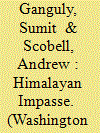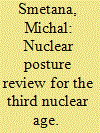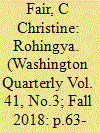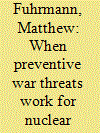|
|
|
Sort Order |
|
|
|
Items / Page
|
|
|
|
|
|
|
| Srl | Item |
| 1 |
ID:
162694


|
|
|
|
|
| Summary/Abstract |
Great power competition is back. As China and the United States ramp up their strategic rivalry, the search is on for a vision of what their evolving great power competition will look like in a globalized and interconnected world. The looming trade war and ongoing technology competition between Washington and Beijing suggest that economics may now be the central battlefield in the bilateral contest. Much of the abundant literature on great power competition and grand strategy focuses on military affairs, and little of it prepares us for what economic and technological competition among great powers looks like, let alone how it will be waged.
|
|
|
|
|
|
|
|
|
|
|
|
|
|
|
|
| 2 |
ID:
162695


|
|
|
|
|
| Summary/Abstract |
In mid-June 2017, Bhutanese authorities detected Chinese personnel, presumably members of the People’s Liberation Army (PLA), building a road in a disputed region of the Doklam plateau near the Bhutan-China-India tri-junction. Lacking the military wherewithal to prevent the activity underway, Bhutan turned to India for assistance.1
1 Vidhi Doshi and Simon Denyer, “China Pushes Hard in Border Dispute with India,” Washington Post, July 6, 2017, https://www.washingtonpost.com/world/asia_pacific/china-pushes-hard-in-border-dispute-with-india/2017/07/06/52adc41e-619b-11e7-80a2-8c226031ac3f_story.html?noredirect=on&utm_term=.0e4267c15214.
View all notes
Within days, Indian Army units were deployed to the area to halt the road construction. Over the next month or so, Indian and Chinese military units became involved in a close confrontation with neither side displaying any interest in standing down. Eventually, the Chinese stopped their activity toward the end of August but did not abandon their claims to the disputed areas.
|
|
|
|
|
|
|
|
|
|
|
|
|
|
|
|
| 3 |
ID:
162691


|
|
|
|
|
| Summary/Abstract |
Since August 1945, when the United States dropped two nuclear bombs on Japan in the closing days of WWII, no nation has employed nuclear weapons during war. Many people at the time fully expected that nuclear weapons would be used again after 1945. Yet, neither Presidents Harry Truman nor Dwight Eisenhower used nuclear weapons in the Korean War; Eisenhower refused requests to use nuclear weapons to bail out the French at Dien Bien Phu in 1954; and President John F. Kennedy and Russian Premier Nikita Khrushchev engaged in secret diplomacy to avoid a nuclear catastrophe during the 1962 Cuban Missile Crisis.
|
|
|
|
|
|
|
|
|
|
|
|
|
|
|
|
| 4 |
ID:
162696


|
|
|
|
|
| Summary/Abstract |
For all of China’s new assertiveness since 2010, the East Asian territorial and maritime disputes, especially those with Southeast Asian claimant states bordering the South China Sea, stand out as the most significant. Yet a decade before, Southeast Asia was also the region where China’s diplomacy had been most successful. So skillful was Chinese policy at the time that the noted China scholar David Shambaugh wrote in 2004 that “most nations in the region now see China as a good neighbor, a constructive partner, a careful listener, and a nonthreatening regional power.”1
1 David Shambaugh, “China Engages Asia: Reshaping the Regional Order,” International Security 29, no. 3 (Winter 2004/2005): 64.
View all notes
It is puzzling that China should have squandered so much diplomatic goodwill and strategic gain painstakingly built up since the late 1990s. For many observers, Beijing has engaged in a self-defeating strategy of alienating its neighbors, damaging its image, and reigniting regional fears of Chinese power, with the risk of strategic isolation and even encirclement.
|
|
|
|
|
|
|
|
|
|
|
|
|
|
|
|
| 5 |
ID:
162687


|
|
|
| 6 |
ID:
162693


|
|
|
|
|
| Summary/Abstract |
In 1996, renowned U.S. defense expert Fred Iklé proposed that the nuclear drama of the past decades had entered its more volatile second act.1
1 Fred Charles Iklé, “The Second Coming of the Nuclear Age,” Foreign Affairs 75, no. 1 (1996).
View all notes
Soon after, the term “second nuclear age” began to be widely used among nuclear strategists.2
2 Keith B. Payne, Deterrence in the Second Nuclear Age (Lexington, KY: University Press of Kentucky, 1996); Colin S. Gray, The Second Nuclear Age (Boulder, CO: Lynne Rienner Publishers, 1999); Paul J. Bracken, Fire in The East: The Rise of Asian Military Power and the Second Nuclear Age (New York, NY: Harper Collins, 1999).
View all notes
Unlike the first age, marked by bipolar competition with the Soviet Union, the main challenge of the second age would come from belligerent regional powers equipped with weapons of mass destruction (WMDs) and ballistic missile technology. However, this era was not thought to last forever—for Professor Colin Gray, even in 1996, wrote the “second nuclear age can be seen as a period of interregnum between irregular cyclical surges in the kind of great power rivalry that organizes many strands in the course of strategic history.”
|
|
|
|
|
|
|
|
|
|
|
|
|
|
|
|
| 7 |
ID:
162688


|
|
|
|
|
| Summary/Abstract |
In 2014, a quiet revolution shook international politics. That year, the World Bank reported that U.S. GDP in purchasing power parity (PPP) terms slipped to second place for the first time since the 1870s.1
1 Calculations based on the World Bank “DataBank,” accessed February 20, 2018, http://databank.worldbank.org/data/home.aspx.
View all notes
From 2014 to 2022, the International Monetary Fund estimates that China’s share of global PPP GDP will rise from 16 percent to more than 20 percent, while the U.S. share will fall from 16 percent to 14 percent.2
2 Calculations based on International Monetary Fund, “World Economic Outlook Database,” accessed February 28, 2018, http://www.imf.org/en/Data.
View all notes
And that is not all. In 2013, China surpassed the United States as the world’s largest trading nation, which Beijing hailed as “a landmark milestone.”3
3 See Angela Monaghan, “China Surpasses US as World’s Largest Trading Nation,” Guardian, January 10, 2014, https://www.theguardian.com/business/2014/jan/10/china-surpasses-us-world-largest-trading-nation.
View all notes
China has also overtaken the United States in total foreign investment, renewable energy production, number of Internet users, and back-end research and development (R&D) spending.
|
|
|
|
|
|
|
|
|
|
|
|
|
|
|
|
| 8 |
ID:
162690


|
|
|
|
|
| Summary/Abstract |
In the vulnerable southeastern Bangladeshi city, Cox’s Bazar, an estimated 1 million Rohingyas languish in spartan refugee camps following brutal ethnic cleansing from their homes in Rakhine, a state over the border in western Myanmar (see Figure 1).1
1 Official estimates suggest that 888,111 have arrived in Bangladesh following the vicious military action against the Rohingya by Myanmar’s Tatmadaw, the country’s armed forces. As of June 30, 2018, the UNHCR claims that there is 888,111 individuals and 204,472 families housed in the sprawling camp complex in Bangladesh’s Cox’s Bazar. UNHCR, “Bangladesh Refugee Emergency Population factsheet (as of June 30, 2018),” July 4, 2018, https://data2.unhcr.org/en/documents/download/64651. Also see International Crisis Group, “Myanmar’s Rohingya Crisis Enters a Dangerous New Phase,” International Crisis Group Asia Report no. 292 (Belgium: International Crisis Group, December 7, 2017): https://d2071andvip0wj.cloudfront.net/292-myanmar-s-rohingya-crisis-enters-a-dangerous-new-phase.pdf. However, Bangladeshi and international NGO officials interviewed by me in June of 2018 assert that the number is more like 1 million. This is in addition to Rohingya in the country from previous exoduses from Myanmar.
View all notes
This was not the first—nor likely to be the last—catastrophe to fall upon the Rohingya, but it has been the most devastating since anti-Rohingya violence in the country began escalating in the early 1990s. Since independence from the British in 1948, the Rakhine state has generally been neglected by Myanmar’s capital, Naypyidaw, affecting the state’s Buddhists, Muslims (not all of whom are Rohingya), Christians, animists and others. There is a long-standing belief among the Buddhist majority that Muslims seek to undermine Myanmar’s Theraveda Buddhist identity, stemming from fears of Rohingya Muslims in particular, but increasingly toward all Muslims in Myanmar generally. Myanmar’s extremist clergy, called Sangha, and their followers are joined by counterparts in Sri Lanka and Thailand who also espouse conspiratorial canards of Muslims weaponizing their fertility and male virility to achieve numerical, social, religious and cultural dominance in these countries, and thus eradicate Theraveda Buddhism in those nations.
|
|
|
|
|
|
|
|
|
|
|
|
|
|
|
|
| 9 |
ID:
162692


|
|
|
|
|
| Summary/Abstract |
On June 7, 1981, eight Israeli F-16 jets dropped bombs on an Iraqi nuclear reactor commonly known as Osiraq. The strike eliminated Iraq’s most critical nuclear facility before it was completed, thereby eroding Saddam Hussein’s capacity to make nuclear bombs. The Osiraq raid may be the most well-known preventive attack in the name of nonproliferation, but it is hardly the only time that countries have targeted nuclear materials or infrastructure militarily.
|
|
|
|
|
|
|
|
|
|
|
|
|
|
|
|
| 10 |
ID:
162689


|
|
|
|
|
| Summary/Abstract |
President Donald Trump’s decision in May 2018 to withdraw from the Iran nuclear deal (formally known as the Joint Comprehensive Plan of Action or JCPOA) threw open the question what to do next? President Trump explicitly declared his intent to negotiate a better deal with Iran, and both houses of Congress, sidelined in the JCPOA process, immediately began discussing drafts to improve on aspects they believed were deficient including ballistic missile development and use, inspection of suspected military installations, and Iran’s military activities in the Middle East region. As this process unfolds, a range of individuals and organizations will articulate, once more, their understanding of what constitutes the U.S. interest in a possible future nuclear deal and more broadly in relation to U.S. policy toward Iran.
|
|
|
|
|
|
|
|
|
|
|
|
|
|
|
|
|
|
|
|
|